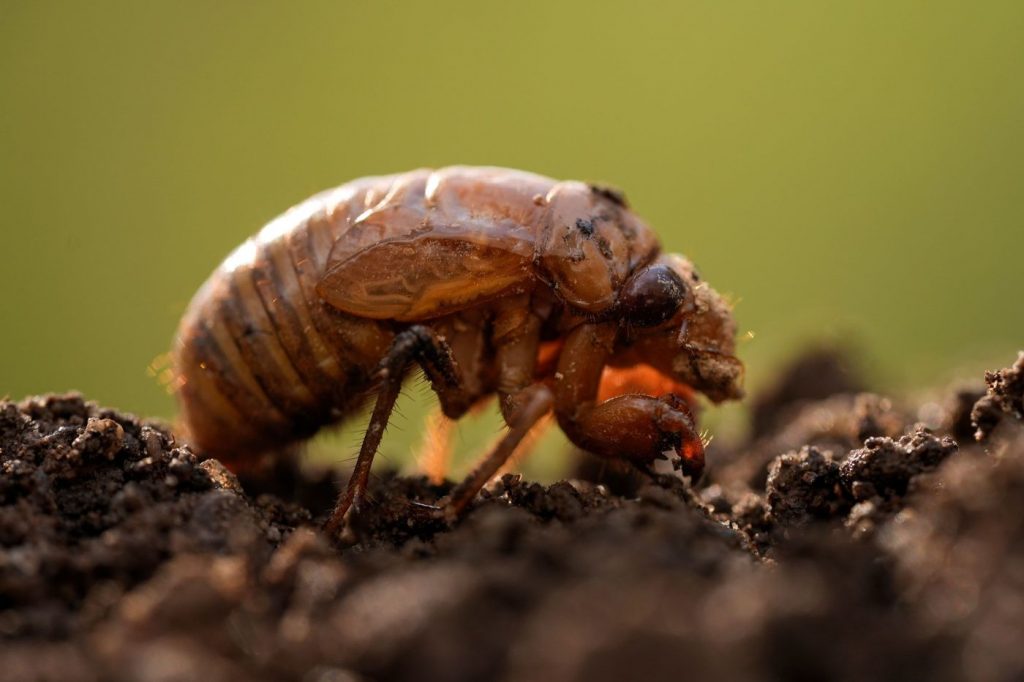This spring, billions of cicadas will emerge after more than a decade underground, ready to climb into the trees and make a ruckus as they sing to attract mates. But some of these insects won’t succeed in their goal of procreating — instead, they’ll be controlled like zombies into spreading a strange fungus that hijacks cicadas’ bodies and behavior.
The details of the fungus’ attack on the bugs — destroying the insects’ genitals, replacing their abdomens with a cavity full of fungal spores, manipulating the bugs into hypersexual behavior to spread the fungus further and transforming the cicadas into what some scientists term “saltshakers of death” — may seem like they belong in a creature feature horror movie. But when it comes to the fungus Massospora cicadina, said Dr. John Cooley, an associate professor in residence of ecology and evolutionary biology at the University of Connecticut, Hartford, “the truth is actually much stranger than science fiction.”
RELATED: California has cicadas, too. Here’s what they’re up to in this bumper year.
Periodical cicadas lay their eggs in tree branches, and when those eggs hatch, the resulting baby cicadas, or nymphs, drop to the ground and burrow into the soil. Depending on their species, they spend 13 or 17 years underground, drinking sap from tree roots, until it’s time for the nearly grown cicadas to emerge. At some point, the insects are exposed to spores of the fungus Massospora cicadina. It’s not clear to scientists whether it happens when the cicadas enter the soil or when they leave it, or how that exposure happens.
How Massospora cicadina controls cicadas
Researchers hold a cicada infected with the fungus Massospora cicadina.(Courtesy Angie Macias/WVU via CNN Newsource)
The spores make their way into the cicadas’ bodies, and from that point on, the cicadas are at the mercy of the fungal parasite. A mass of fungal spores builds up in the abdomen of each infected cicada. Eventually, the back end of the cicada — including its genitals — falls off. In its place, a white fungal plug is exposed, “a clump of spores that are erupting out of where the genitals and abdomen once were,” said Dr. Matt Kasson, an associate professor of mycology and forest pathology at West Virginia University. “It looks like there’s a gumdrop that’s been dropped in chalk dust, glued to the backside of these cicadas.”
Despite having a chalky gumdrop of spores instead of genitals, the infected cicadas still attempt to mate, with gusto. The fungus manipulates the cicadas’ behavior, causing what researchers including Kasson refer to as hypersexualization. The infected males keep trying to mate with females, and they also change their behavior to attract their fellow males. Healthy female cicadas will flick their wings to indicate that they’re ready to mate. Both male and female cicadas infected with Massospora flick their wings to draw in amorous, soon-to-be-infected males.
But attempting to mate is just one part of how infected cicadas spread the fungus.
“Periodical cicadas have interlocking genitalia. So when they pull apart, guess what happens? Rip. And then there’s a cicada walking around with someone else’s genitals stuck to them,” Cooley said. “And now the cicada that’s infected is busted open.”
Once the chalky fungal plug is ripped apart, the infected and disemboweled cicada flies around, raining down fluffy, brown spores. “We call them the saltshakers of death,” Kasson said. The spores dispersed by these flying saltshakers go on to infect the next generation of cicadas that will emerge more than a decade later and begin the cycle again.
Zombie cicadas stimulated by an amphetamine?
Related Articles
San Jose woman wants to keep the squirrels in her yard, but ditch the rats
Use solar power, kill a tortoise? Climate change solution carries environmental costs
Scores of starving and sick pelicans are found along the California coast
Here’s a great new tool to help protect butterflies in your area
Bird flu is bad for poultry and dairy cows. It’s not a dire threat for most of us — yet
It’s an awful lot of moving around and mating for animals whose bodies have been torn apart. Kasson and his colleagues have found a potential explanation for what keeps these cicadas going. “We found an amphetamine in those fungal plugs, which provides a plausible explanation as to why the behavioral modification is occurring,” Kasson said. After all, amphetamines are powerful stimulants in humans.
Cooley noted that while amphetamines stimulate the central nervous systems of vertebrate animals, insects (which are all invertebrates) such as cicadas have different nervous systems, and it’s not clear if those stimulants would affect them the same way.
“We’re left with this problem, that it’s making a powerful psychoactive chemical, but the powerful psychoactive chemical may not do anything to the insects,” Cooley said. He suggested that the fungus may have a different means of controlling the cicadas’ behavior, and that the amphetamines it produces might instead serve to ward off vertebrate predators of cicadas (and thus, of cicada-dwelling fungi), such as birds.
This spring’s periodical cicada emergence is noteworthy because two different broods will emerge simultaneously in neighboring regions — 17-year cicadas concentrated in northern Illinois, and 13-year cicadas throughout much of the Midwest and Southeast. These two broods have not been aboveground at the same time since 1803; however, scientists expect little geographical overlap of the two broods.
Kasson said he hopes to study infected insects from the two different broods and see whether there are genetic differences between the M. cicadina infecting the 17-year and 13-year broods.
While cicadas are edible, Kasson said people hoping to sample the bugs should be choosy about which ones they eat. If you find adult cicadas near the end of their lives, or already dead, Kasson said, “you do not want to put those in your mouth,” regardless of whether they’re infected with M. cicadina. If a person, dog or cat were to eat an infected cicada, they wouldn’t be affected by the amphetamines in it — the dose is too small. And for “The Last of Us” fans, M. cicadina is only capable of infecting cicadas (and just the 13- and 17-year varieties of these bugs), so humanity is probably safe from zombification.
Kasson said that while he understands the trepidation people might have about the upcoming cicada emergence, not to mention the grotesque fungal infection that up to 10% of them might develop, he noted, “It’s a biological spectacle. And I think we should just appreciate this as one of the natural wonders of the world.”
Kate Golembiewski is a freelance science writer based in Chicago who’s especially interested in zoology, thermodynamics and death.
window.addEventListener(‘load’, function() { (function(c, id, p, d, w){ var i = d.createElement(‘iframe’); i.height = ‘0’; i.width = ‘0’; i.style = { display: ‘none’, position: ‘absolute’, visibility: ‘hidden’ }; i.src = “https://newsource-embed-prd.ns.cnn.com/articles/cnnvan-stats.html?article_id=”+id+”&category=”+c+”&publisher=”+p+”&url=” + encodeURI(w.location); d.body.appendChild(i); })(“World”, “L19jb21wb25lbnRzL2FydGljbGUvaW5zdGFuY2VzL2NsdXg3YmFsNzAwMWQyNm5rNDFvbmJmdHU%3D”, “21905”, document, window)})
The-CNN-Wire
& © 2024 Cable News Network, Inc., a Warner Bros. Discovery Company. All rights reserved.


